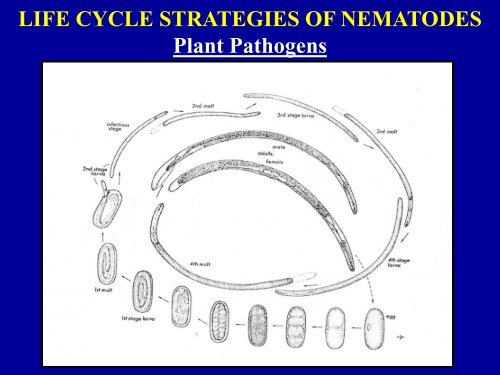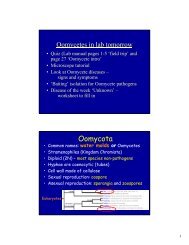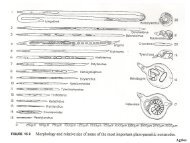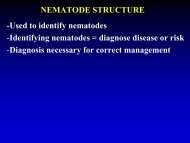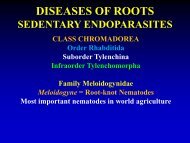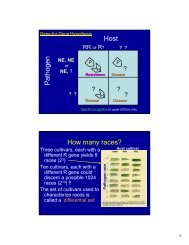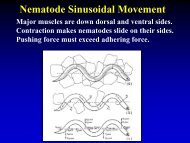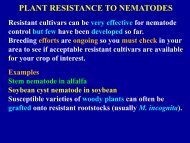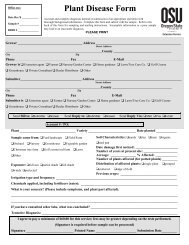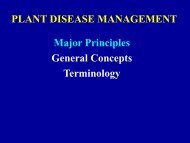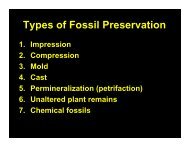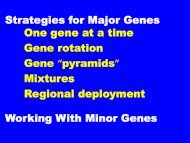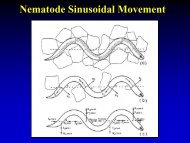Life cycle strategies of plant-parasitic nematodes
Life cycle strategies of plant-parasitic nematodes
Life cycle strategies of plant-parasitic nematodes
Create successful ePaper yourself
Turn your PDF publications into a flip-book with our unique Google optimized e-Paper software.
LIFE CYCLE STRATEGIES OF NEMATODES<br />
Plant Pathogens
LIFE CYCLE STRATEGIES OF NEMATODES<br />
Root Pathogens<br />
Ectoparasites = body remains outside <strong>of</strong> <strong>plant</strong> tissue<br />
Endoparasites = whole nematode enters <strong>plant</strong> tissue<br />
Migratory = move around throughout life<br />
Sedentary = adult females feed in one location only
LIFE CYCLE STRATEGIES<br />
Root Pathogens<br />
Migratory Ectoparasites - feed outside <strong>of</strong> root, move<br />
cell-to-cell but do not enter root.<br />
Lance Nematodes<br />
D.W. Dickson
LIFE CYCLE STRATEGIES OF NEMATODES<br />
Root Pathogens<br />
Needle Nematode<br />
Migratory Ectoparasite<br />
S. Edwards
LIFE CYCLE STRATEGIES<br />
Root Pathogens<br />
Migratory<br />
Ectoparasites<br />
= most common type <strong>of</strong><br />
<strong>plant</strong> parasite.<br />
Includes all virus<br />
vector <strong>nematodes</strong>.<br />
Stylet<br />
Head<br />
Dagger Nematode<br />
U. Wyss
LIFE CYCLE STRATEGIES<br />
Root Pathogens<br />
Sedentary Ectoparasites - head enters root but body<br />
remains outside, no movement after this.<br />
Reniform Nematode<br />
R.B. Rebois
Citrus nematode<br />
Tylenchulus semipenetrans<br />
APS Slide Set #32
Tylenchulus semipenetrans = citrus nematode<br />
Nematode molts<br />
3 times to become<br />
an adult<br />
Posterior remains<br />
in soil and female<br />
swells with eggs<br />
J2 penetrate<br />
outer layers<br />
<strong>of</strong> cortex
Tylenchulus<br />
semipenetrans<br />
Nurse Cells<br />
APS Slide Set #33
LIFE CYCLE STRATEGIES<br />
Root Pathogens<br />
Migratory Endoparasites - tunnel inside root but<br />
move back to soil and into new roots at will.<br />
Root-lesion Nematodes<br />
H. Jensen
Pratylenchus spp. – Root-lesion Nematode<br />
All stages from J2 to<br />
adult remain vermiform<br />
and move in and out <strong>of</strong><br />
roots<br />
J.D. Eisenback
Pratylenchus spp. – Root-lesion Nematode<br />
Root-lesion nematode in cortical cell
Pratylenchus spp. – Root-lesion Nematode<br />
Males are common in some species<br />
while other species have few to no males
Pratylenchus spp. – Root-lesion Nematode<br />
Eggs are usually laid in<br />
root tissues but may be<br />
deposited in soil as well
Root-lesion <strong>nematodes</strong> in roots<br />
(migratory endoparasites with 6-9 week reproductive <strong>cycle</strong>)<br />
juvenile<br />
eggs
LIFE CYCLE STRATEGIES<br />
Root pathogens<br />
Sedentary Endoparasites - tunnel into root and establish<br />
feeding site, females do not move but may rupture root as<br />
they enlarge.<br />
Root-knot nematode - gall forms<br />
around nematode, eggs laid outside<br />
Cyst nematode - no gall, nematode pops<br />
out <strong>of</strong> root, eggs retained in body
Root-knot Nematode Eggs<br />
First Molt Occurs in Egg<br />
K. Merrifield
Meloidogyne second-stage juvenile (J2)<br />
Hatches from egg = migratory stage in soil<br />
Only infective stage.<br />
G. Santo
Meloidogyne J2<br />
J.D. Eisenback
Meloidogyne incognita J2<br />
Infecting Cotton Root Tip<br />
R.S. Hussey
Meloidogyne Juvenile Stages<br />
All inside root<br />
J2 J3 J4<br />
E.C. Bernard
Meloidogyne incognita<br />
Feeding on Giant Cells<br />
N.T. Powell
Root Forms Gall Around Female<br />
Eggs Are Laid in Egg Mass<br />
R.S. Hussey
Meloidogyne incognita Adult Male<br />
Coiled Inside 4 th Stage Juvenile Cuticle<br />
Adult<br />
Head<br />
J4 Head<br />
R.S. Hussey
Male Root-knot Nematode<br />
Migratory stage in soil<br />
G.S. Abawai
Stained Adult Female Meloidogyne<br />
K. Merrifield
Eggs <strong>of</strong> Cyst Nematode May Stay<br />
Protected Inside Cyst for Years<br />
Ulrich Zunke
Some Cyst Nematodes<br />
Require a “Hatching Factor”<br />
From the Host Plant<br />
Globodera rostochiensis<br />
Eggs and J2s<br />
U. Zunke
Heterodera glycines (Soybean Cyst Nematode)<br />
J2 Infecting Soybean Root<br />
J.D. Eisenback
J2 Infect Roots and Nematode<br />
Develops Similar to Meloidogyne<br />
D. Inglis
Females enlarge and emerge from root<br />
while head stays buried in root and feeds<br />
Mature Female<br />
Potato Cyst<br />
Nematode<br />
Theirry Vrain
Roots Do Not Form<br />
Galls Around<br />
Cyst Nematodes<br />
R.S. Hussey
Heterodera glycines on Soybean Roots<br />
R.A. Motsinger
Golden Potato Cyst - Globodera rostochiensis<br />
Pale Potato Cyst - Globodera pallida<br />
Potato Cyst Nematodes Feeding on Root<br />
Ulrich Zunke
Color Changes During Cyst Maturation<br />
Globodera<br />
J.A. Fox
Brown Cysts <strong>of</strong> Globodera<br />
Opened to Expose Eggs and J2<br />
J.A. Fox
LIFE STRATEGIES OF FOLIAR NEMATODES<br />
Nematodes crawl up <strong>plant</strong> in film <strong>of</strong> water and/or<br />
migrate inside <strong>plant</strong> to reach destination<br />
Feeding <strong>strategies</strong> vary at different points <strong>of</strong> their life <strong>cycle</strong>s:<br />
Migratory ecto migratory endo sedentary endo<br />
Examples:<br />
- stem and bulb nematode<br />
- foliar nematode<br />
- seed gall nematode
WORLD’S MOST IMPORTANT<br />
PLANT-PATHOGENIC NEMATODES<br />
Weighted<br />
Importance<br />
Common Name Genus <strong>Life</strong> Cycle Strategy Ranking<br />
Root-knot Meloidogyne Sedentary Endoparasite 1375<br />
Root-lesion Pratylenchus Migratory Endoparasite 782<br />
Cyst Heterodera Sedentary Endoparasite 606<br />
Stem & Bulb Ditylenchus Diverse Strategies 251<br />
Potato Cyst Globodera Sedentary Endoparasite 244<br />
Citrus Tylenchulus Sedentary Ectoparasite 233<br />
Dagger Xiphinema Migratory Ectoparasite 205<br />
Burrowing Radopholus Migratory Endoparasite 170<br />
Reniform Rotylenchulus Sedentary Ectoparasite 142<br />
Spiral Helicotylenchus Migratory Ectoparasite 122
ROOT PARASITES<br />
Migratory Ectoparasites - feed on outside <strong>of</strong> root, move from cell to cell but do<br />
not enter the root. Example = dagger nematode<br />
Sedentary Ectoparasites - head enters root but body remains outside, nematode<br />
does not move after this. Example = citrus nematode ( also referred to as<br />
semiendoparasites or ecto-endoparasites<br />
Migratory Endoparasites - feed inside root, tunnel inside root and move back<br />
into soil and to new root at will. Example = root-lesion nematode<br />
Sedentary Endoparasites - tunnel inside root and establish feeding site, females<br />
do not move and may rupture outside <strong>of</strong> root as they grow, adult males move back<br />
into soil. Example = root-knot and cyst <strong>nematodes</strong><br />
ABOVEGROUND PARASITES<br />
Nematodes that are parasites <strong>of</strong> stems, leaves or seeds may crawl up the <strong>plant</strong> in a<br />
film <strong>of</strong> water on stems and leaves or migrate through tissues to reach their<br />
destination. Some species may utilize several <strong>of</strong> the <strong>strategies</strong> above at different<br />
points in their life <strong>cycle</strong>. Examples = stem and bulb nematode, foliar nematode,<br />
seed gall nematode.
ROOT-LESION NEMATODE LIFE CYCLE<br />
Pratylenchus spp.
Root-lesion Nematode


